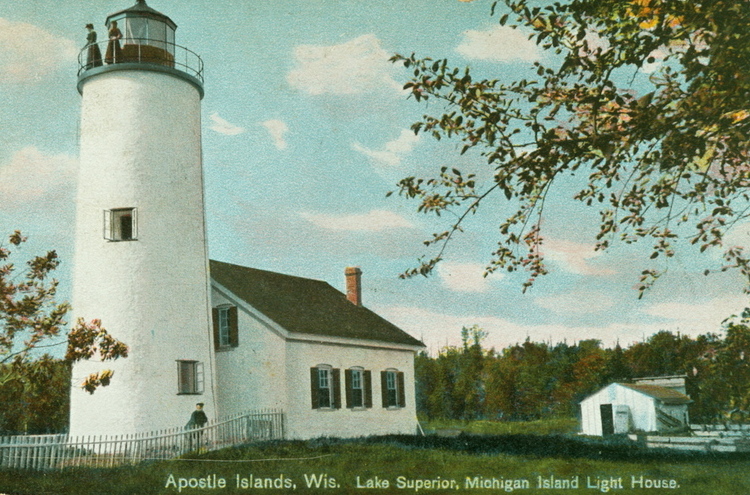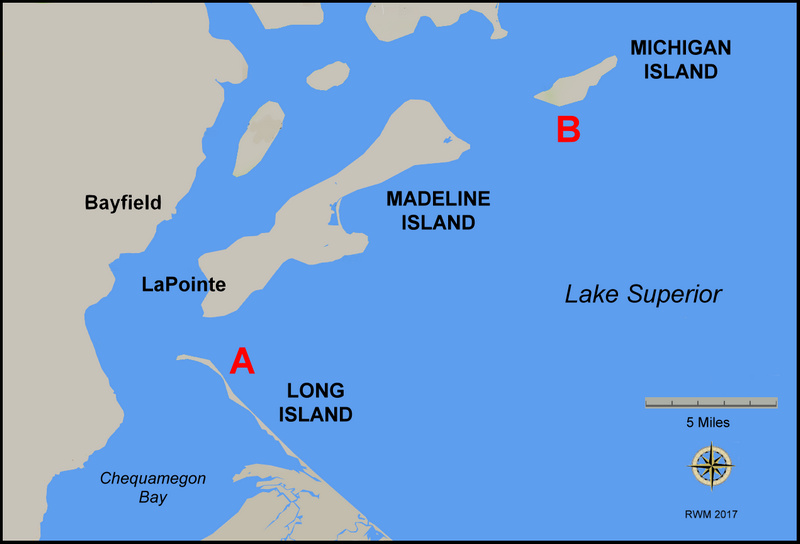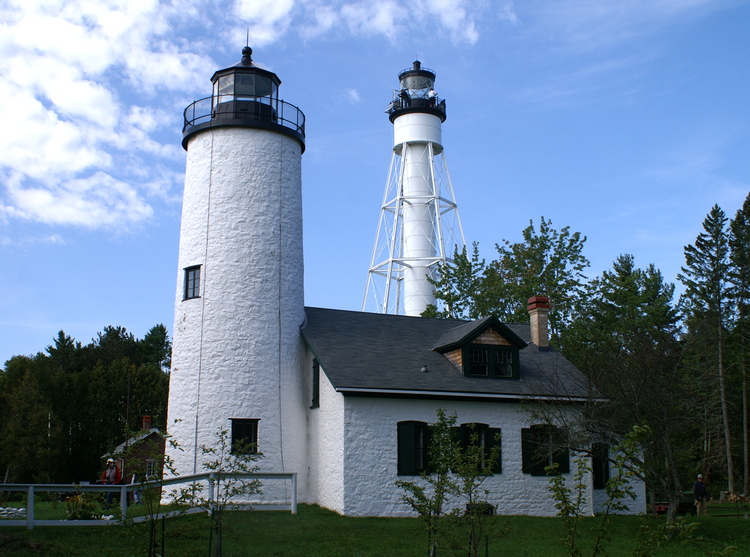The Nation’s Largest Collection Of Lighthouse Bloopers, Part 2
Continuing an examination of the series of articles on the lighthouses of the Apostle Islands appearing on the maritime web site, boatnerd.com.
Back to Part 1
Part Two: The Michigan Island Lights
Under discussion: The Michigan Island Lights, by Dave Wobser
Let's turn now from the general regional history repeated verbatim on all but one page of the Boatnerd articles, to the information presented on the individual lighthouses, beginning with the oldest.

Michigan Island has the distinction of having the first and last lighthouses constructed in the Apostle Islands. Both are still standing. This island’s lighthouses marked the eastern edge of the island chain for vessels heading to Ashland to load iron ore from the Gogebic Range.
Misleading: the mines of the Gogebic Range did not begin production until 1884, nearly three decades after the construction of the original Michigan Island lighthouse, and Ashland’s first ore dock came two years after that. The initial intended purpose of the beacon was to guide ships to the harbor at La Pointe, the old fur trade post on Madeline Island.
Interestingly, there was no authorization for the light and it only operated for one shipping season. It is thought that the light was to have been constructed on Long Island, but the mistake was not discovered until completion of the Michigan Island light.
The story of the Michigan Island lighthouse is indeed a puzzler, but the writer is presenting an outdated hypothesis here. The placement of the lighthouse at a spot different from the one originally intended was not a simple mistake, but the result of a deliberate change of plans authorized by a government official.
In 1854, the U.S. Lighthouse Board issued a contract to the Milwaukee construction firm of Sweet, Ransom, and Smith to build eleven lighthouses on the “Northwest Lakes.” Among them was to be a beacon at the tip of “Chagwamegon Point,” the skinny sandbar now known as Long Island, to guide traffic to La Pointe, the old fur trade village which was still the only substantial settlement in the region. A light there (point A on map) would make an excellent signpost to the La Pointe harbor, which sits on the landward side of Madeline Island, hidden from the open lake.

Instead, when the job was finished in the fall of 1856, the brand-new lighthouse blazed from atop a bluff on Michigan Island (point B on map), seventeen miles from its intended location. For many years, no explanation could be found for this discrepancy, and the most common guess was that somewhere along the line, due perhaps to a vaguely written contract or faulty communication between headquarters and the field, somebody screwed up and put the lighthouse on the wrong island.
However, documents unearthed in the late 1990s showed that the location change was not a mistake or misunderstanding, but was done by order of the Lighthouse Board’s representative on the scene. One Abraham Smolk, “Superintendent of Lighthouse Building on Lake Superior,” ordered on-the-fly revisions to the omnibus contract for three of the eleven planned lighthouses, the La Pointe light among them. The contractor grudgingly acceded, but later filed a claim for the extra costs incurred due to the change orders. It is this carefully documented expense voucher that eventually solved the Michigan Island mystery. The document does not explain Smolk’s reasoning, but it is noteworthy that two of his three revisions moved the beacon from lake level to a clifftop, and this writer suspects he may have been overly concerned with the elevation factor.
Though not a literal “mistake,” Smolk’s decision was definitely unwise. As Wobser correctly notes, the Michigan Island lighthouse was shuttered after its first season of operation, then relit in 1869. Unfortunately, on the bluff where it was built, the lighthouse was hidden from mariners until they were well along on their course and already past an area of hazardous shoals. Several ships ran aground here as a result, but fortunately only two lives were lost in the wrecks.

After years of dithering, the Lighthouse Service finally addressed this problem by erecting a much taller tower on the site. The Boatnerd description of the second beacon contains one glaring gaffe and a minor, misleading bit of sloppy writing.
The structure is similar in design to towers at Rawley Point on Lake Michigan and Whitefish Point at the east end of Lake Superior. The Michigan Island tower differs in that a small brick building is located at the base of the center cylindrical tube and inside the six legs that support the structure.
Wrong. The little entrance house at the base of the tower is cast iron like the rest of the structure. Go knock on it some day.

Not brick!
This building apparently served as a workroom for the early keepers.
The “early keepers” never set foot in the building. Only the station’s last two keepers and their several assistants even saw it.
Coming up next: some real howlers about the three lighthouses on Long Island.
Next: The La Pointe Light Station
|